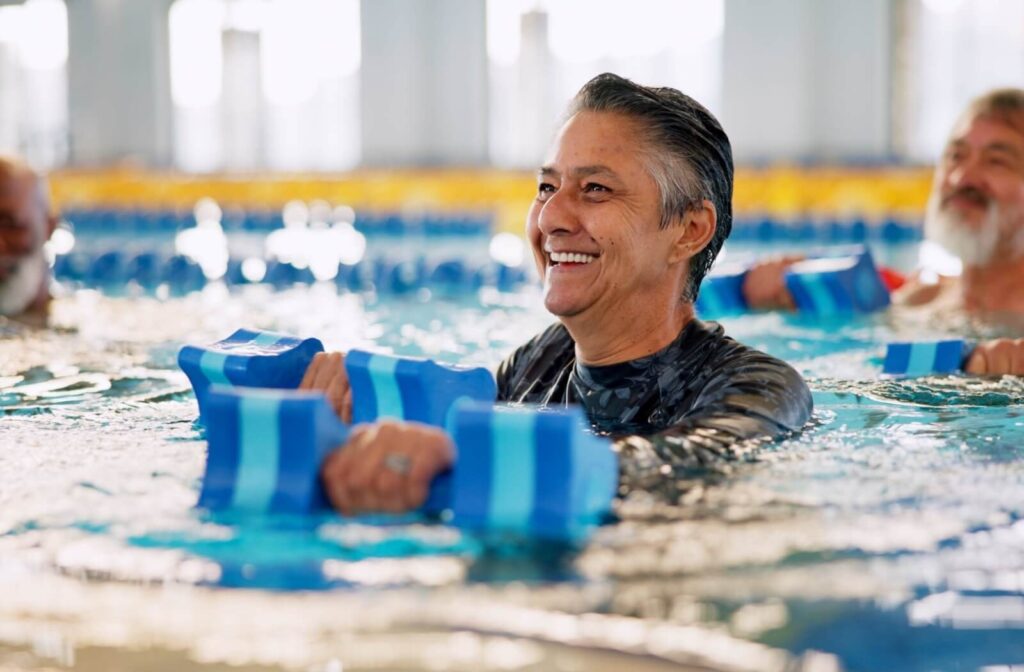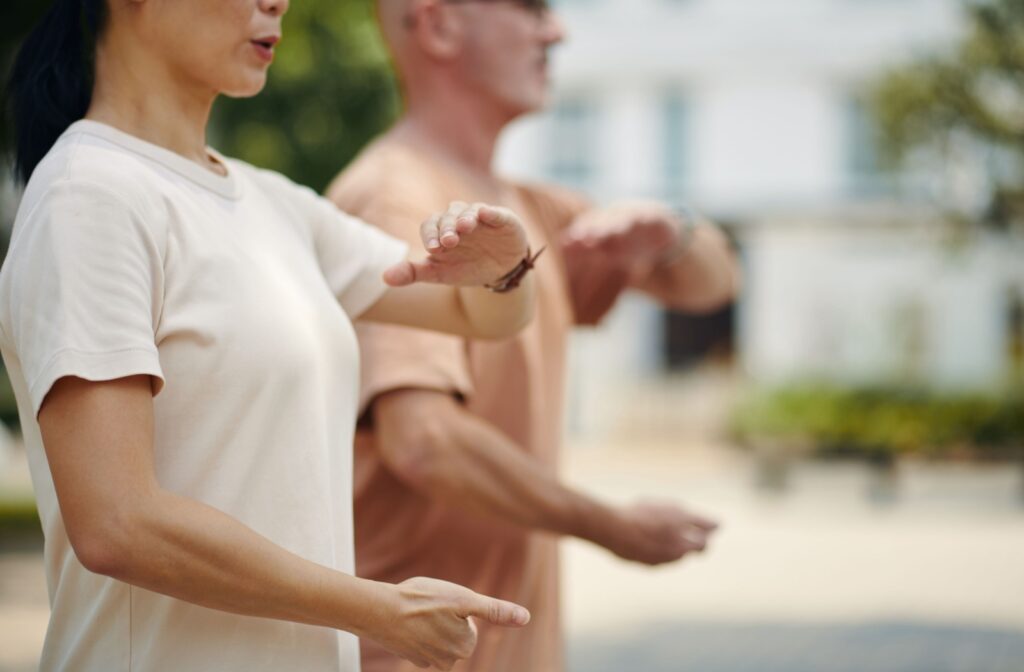Key Takeaways
- Weight-bearing and resistance exercises help slow down bone loss and reduce the risk of fractures.
- Safe exercise guidelines include avoiding twisting movements and maintaining proper form to prevent injury.
- Low-impact activities like water aerobics and tai chi provide joint-friendly strengthening.
- Professional guidance in senior living communities promotes safe and consistent exercise routines.
- Regular movement benefits balance, coordination, and overall independence.
Osteoporosis Exercises for Seniors to Stay Active and Strong
Living with osteoporosis doesn’t mean you have to give up an active lifestyle. When your bones become more fragile, the right exercises can actually help slow bone loss and improve your strength, balance, and coordination.
The seven most effective osteoporosis exercises for seniors include walking, chair squats, standing balance work, water aerobics, tai chi, light resistance training, and gentle yoga—all designed to strengthen bones while keeping you safe and comfortable. At assisted living communities and senior care settings, these activities form the foundation of wellness programs that help you maintain your independence and quality of life.
Why Exercise Matters for Bone Health in Seniors
Osteoporosis causes your bones to lose density and become more prone to fractures. This condition affects millions of seniors, making everyday activities feel more challenging and increasing the risk of falls.
Physical activity plays a powerful role in slowing bone loss by stimulating bone-building cells. When you put gentle stress on your bones through movement, your body responds by maintaining and even building bone tissue.
Beyond bone strength, regular exercise improves your balance and coordination, which directly helps prevent falls. Getting clearance from your healthcare provider before starting any new exercise routine allows you to move forward safely and confidently.
Safe Exercise Guidelines for Seniors with Osteoporosis
Certain movements can put too much stress on fragile bones, particularly those involving forward bending or twisting of the spine. Activities such as toe touches, sit-ups, or golf swings may increase the risk of fractures.
Maintaining proper spinal alignment during all exercises protects your vertebrae from compression fractures. Keep your shoulders back, chest open, and avoid hunching forward during movement.
Starting slowly and progressing at your own pace prevents injury and builds confidence. The hook lying position—lying on your back with knees bent—provides a safe starting point for many exercises. If you experience sharp pain or unusual discomfort, stop immediately and consult your healthcare provider.
Weight-Bearing Exercises That Strengthen Bones
Walking for Daily Bone Health
Brisk walking targets the bones in your legs and hips, areas commonly affected by osteoporosis. This simple activity puts just enough stress on these bones to encourage strength building.
Working up to 30-45 minutes per day provides maximum bone health benefits. You can break this into shorter 10-15-minute walks throughout the day if that feels more manageable.
Many senior living communities feature walking paths and indoor spaces that make daily walking convenient and enjoyable year-round.
Chair Squats and Balance Exercises
Chair squats help you practice the sit-to-stand movement safely while strengthening your leg muscles and hip bones. Start by sitting in a sturdy chair, then stand up without using your hands for support.
One-leg balance exercises improve stability by challenging your core and leg muscles. Hold onto a wall or sturdy surface while lifting one foot slightly off the ground for 10-30 seconds.
These movements directly translate to better balance in daily activities, reducing your risk of falls and fractures.
Standing on One Leg and Hip Exercises
Outward hip rotation strengthens the muscles around your hip joints while you stand on one leg. Lift your knee to hip level, then rotate it outward while maintaining your balance.
The drinking bird exercise targets your glutes and hamstrings by having you hinge forward at the hips while standing on one leg, similar to a bird drinking water.
Always use a wall, chair, or railing for support when needed—safety should be your top priority in any exercise routine.

Low-Impact Exercises for Joint-Friendly Movement
Water Aerobics Benefits
Water provides natural resistance for strength training while supporting your joints and reducing impact. This makes water aerobics perfect for building bone strength without joint stress.
Group water classes offer social interaction that makes exercise more enjoyable and helps you stay consistent with your routine. Many participants find the supportive environment encouraging and motivating.
The cardiovascular benefits of water aerobics support your overall health while targeting bone strength in your arms, legs, and core.
Gentle Movement Options
Tai chi combines slow, flowing movements with balance challenges that strengthen bones while improving coordination. This ancient practice has been shown to reduce fall risk in seniors.
Dancing provides weight-bearing exercise disguised as a fun social activity. Whether ballroom, line dancing, or gentle movement to music, dancing engages multiple muscle groups.
Gentle yoga poses support bone health through weight-bearing positions and improved flexibility, though you’ll want to avoid forward bends and twisting poses.
Strength Training and Resistance Exercises
Lightweight training twice a week helps build bone density in your arms, spine, and legs. Start with 1-2 pound weights or resistance bands and gradually increase as you get stronger.
Incline push-ups against a wall or sturdy table provide upper-body strengthening without the stress of floor push-ups. Stand arm’s length from the wall and push against it.
Upper body exercises like dumbbell curls and overhead presses target the bones in your arms and shoulders. Isometric exercises, where you hold a position without movement, protect your spine while building strength.
These exercises specifically help increase bone density in your forearm and thigh bones, areas that benefit greatly from regular resistance work.
Creating Your Exercise Routine in Senior Care Settings
Working with senior living staff helps you develop a personalized program that fits your health needs and abilities. Professional guidance makes exercise safer and more effective.
Assisted living communities often feature fitness programs specifically designed for residents with osteoporosis and other health conditions. These programs provide structure and professional supervision.
With 24/7 support for seniors, you have assistance available whenever you need help with exercises or have questions about your routine. This support system removes barriers that might prevent consistent exercise.
For those with dementia or memory concerns, adapted exercises and additional supervision help maintain physical activity safely. Building consistency becomes easier with professional guidance and scheduled activity times.
Supporting Your Loved One’s Active Lifestyle
Finding senior care that prioritizes physical wellness means looking for communities with comprehensive fitness programs and qualified staff. Professional supervision provides peace of mind for both residents and families.
Regular movement helps maintain independence by keeping bones strong, muscles active, and balance sharp. Choosing senior living options with comprehensive wellness programs supports long-term health and quality of life.
At Massey Springs Senior Living, we recognize the importance of staying active for maintaining bone health and overall well-being. Our wellness programs are designed with your safety and success in mind, providing the professional guidance and 24-hour support you need to maintain an active lifestyle.
Contact us today to schedule a tour and see how our comprehensive approach to senior care can support your health and independence.


